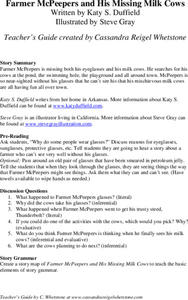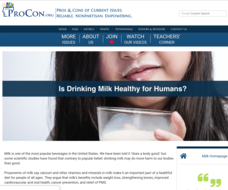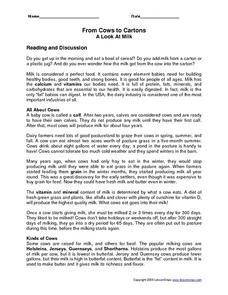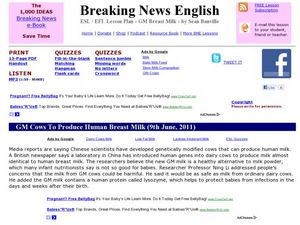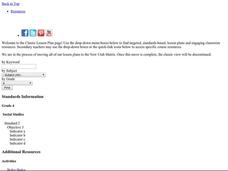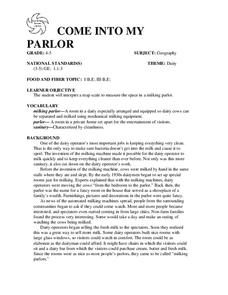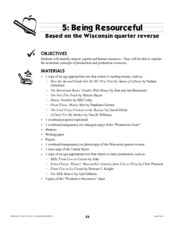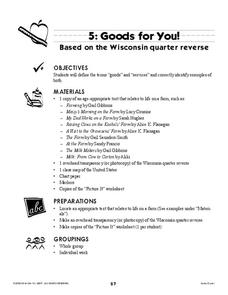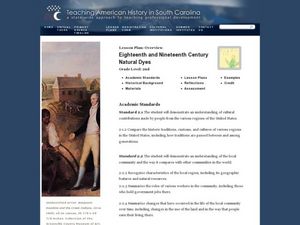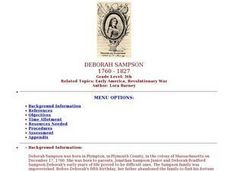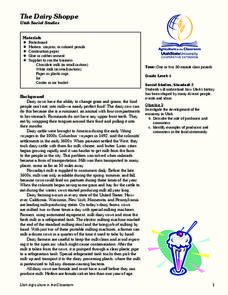Cassandra Reigel Whetstone
Farmer McPeepers and His Missing Milk Cows
Pair your reading of Farmer McPeepers and His Missing Milk Cows with the questions and activities provided here. Learners answer questions about the text, create story maps, put together brochures, relate math to the story, practice...
Curated OER
Producers to Consumer - Milk and Trees
For this producers and consumers worksheet series, learners make two small books; one about how milk is produced and processed starting from cows, and the other is about how trees become lumber and other products. They cut out consumer...
ProCon
Milk
Milk: It does a body good ... or does it? Using the provided website, scholars sort through information to answer the question. They review a chart demonstrating lactose intolerance by ethnicity and region, and they also compare the...
Curated OER
Come Into my Parlor
An interesting cross-curricular lesson plan on dairy farming awaits your students. Elements of language arts, math, social studies, and agriculture are all present. Many excellent worksheets and a good article on dairy farming are...
Curated OER
From Cows To Cartons a Look At Milk
In this dairy industry worksheet, students complete 5 multiple choice and 10 true or false questions based on reading about cows, milk and the dairy industry.
Curated OER
Breaking News: GM Cows to Produce Human Breast Milk
Learners explore current events by reading and analyzing an article in class. In this human diet lesson, students read an article about cows which are being genetically modified in order to produce human breast milk for consumption....
Curated OER
Milk and Dairy, Day 1
Students review different types of milk products and their characteristics, demonstrate how to select and prepare milk and milk products, identify standard serving sizes, define terms associated with milk and milk products, and practice...
Curated OER
The Dairy Shoppe
Fourth graders examine the dairy industry. In this Social Studies lesson, 4th graders investigate the various products made from milk. Students look at entrepreneurship and independent farmers in the dairy industry.
Curated OER
COME INTO MY PARLOR
Students interpret a map scale to measure the space in a milking parlor. They reveiw the process of using a map scale to calculate distances. Students are given worksheets, they read the information in the box together. They draw an...
Curated OER
The Great Chicago Fire: Did Mrs. O'Leary's Cow Really Cause It?
Students research the Great Chicago Fire and its myths on how it started. They use their critical thinking skills to determine what really happened. They write an essay supporting their opinion on the fire.
Curated OER
Bovine Oversteps Boundaries
Seventh graders read a newspaper account of "Grady the Silo Cow" and complete news-writing activities. In this news-writing lesson, 7th graders read the newspaper account about the cow. Students examine newspapers and work in groups to...
Curated OER
Serfs and Lords
Students determine what the roles of serfs and lords were in feudal society. In this feudalism lesson, students examine what life was like for the different classes by looking at farm and manor life. They listen to Till Year's Good End,...
Curated OER
Folk and Popular Culture
Good enough for a college class, this resources discusses multiple aspects pertaining to the issues with globalization and the differences between pop and folk culture. It defines major terminology, provides concrete examples, and...
Lee & Low Books
First Come the Zebra Teacher’s Guide
Accompany a reading of First Come the Zebra written and illustrated by Lynne Barasch with a teacher's guide equipped with before reading, vocabulary, and after reading activities. Additional social studies,...
Curated OER
Living in a Community
Students practice their reading comprehension skills by reading articles about living in a community. They answer questions related to the material to test for comprehension.
Curated OER
Being Resourceful: Wisconsin quarter reverse
If your class understands goods and services then they'll be ready for this lesson on various resources. After reading a series of books and engaging in class lecture and discussion, pupils will fill out worksheets. They will list...
Curated OER
Goods for You!
Have your class learn about Wisconsin and farming. Learners begin by listening to stories that describe farming and engage in a discussion of goods and services. They could also compare the goods and services provided in different states.
Curated OER
Better Butter
Students explore the process of making butter. In this agriculture lesson, students discuss how butter is made today and how it was made in the past. Students make their own butter using baby food jars and some "elbow grease."
Curated OER
Producer to Consumer Fun
Students research about producers and consumers. They examine how products become available to consumers and participate in one of the activities listed such as: tour a farm or a factory, go on a scavenger hunt at a local store, or have...
Curated OER
A Rooster and a Bean Seed
Learners hear a folk tale and participate in a simulation that helps them recognize problems with barter and benefits of monetary exchange.
Curated OER
Eighteenth and Nineteenth Century Natural Dyes
Second graders explore the work of Americans when it came to coloring materials. In this interdisciplinary activity, 2nd graders follow the provided steps to make natural goldenrod dye from scratch.
Curated OER
Deborah Sampson
Fifth graders describe the major accomplishments of Deborah Sampson and her importance in American history. They list in chronological order the evets that took place in Deborah Sampson's life. They demonstrae their ability to...
Curated OER
The Dairy Shoppe
Fifth graders research dairy farming and learn about dairy products as well as dairy processing. In this dairy instructional activity, 5th graders read background information about dairy farming and processing. Students discuss running a...
Curated OER
Goods for You!
Learners define "goods" and "services" and identify examples of both. They read farm books and discuss what we use from animals and plants on a farm. They observe the Wisconsin quarter reverse and locate Wisconsin on a map.
